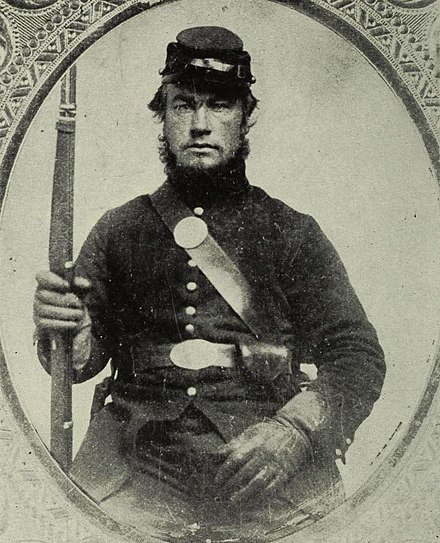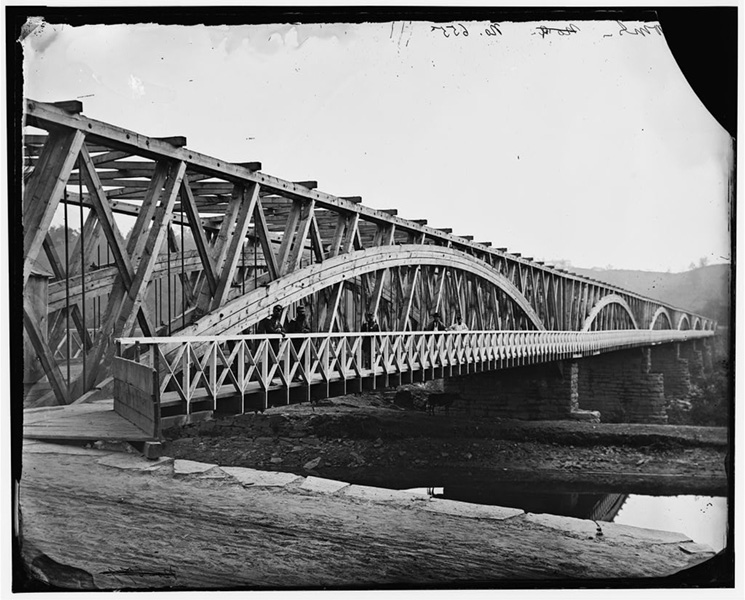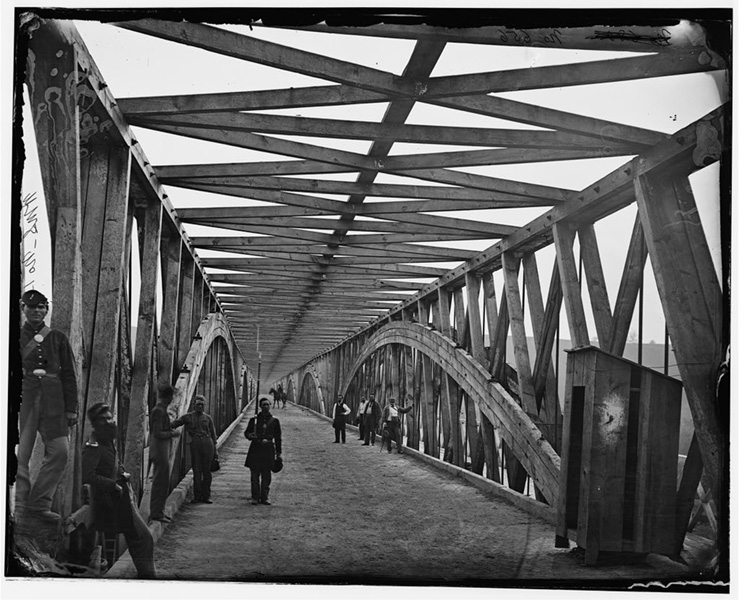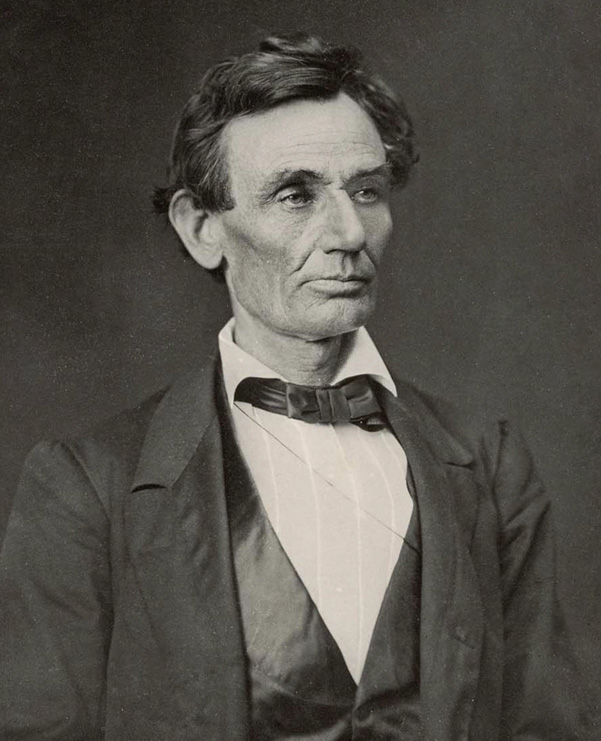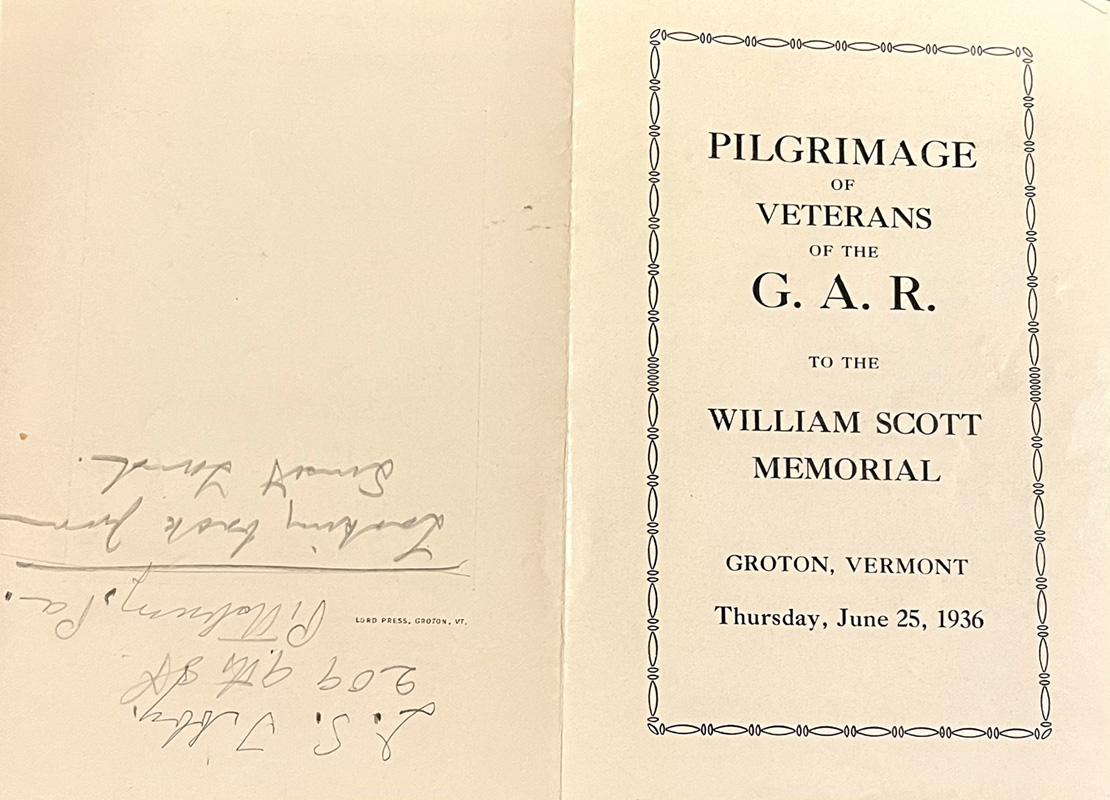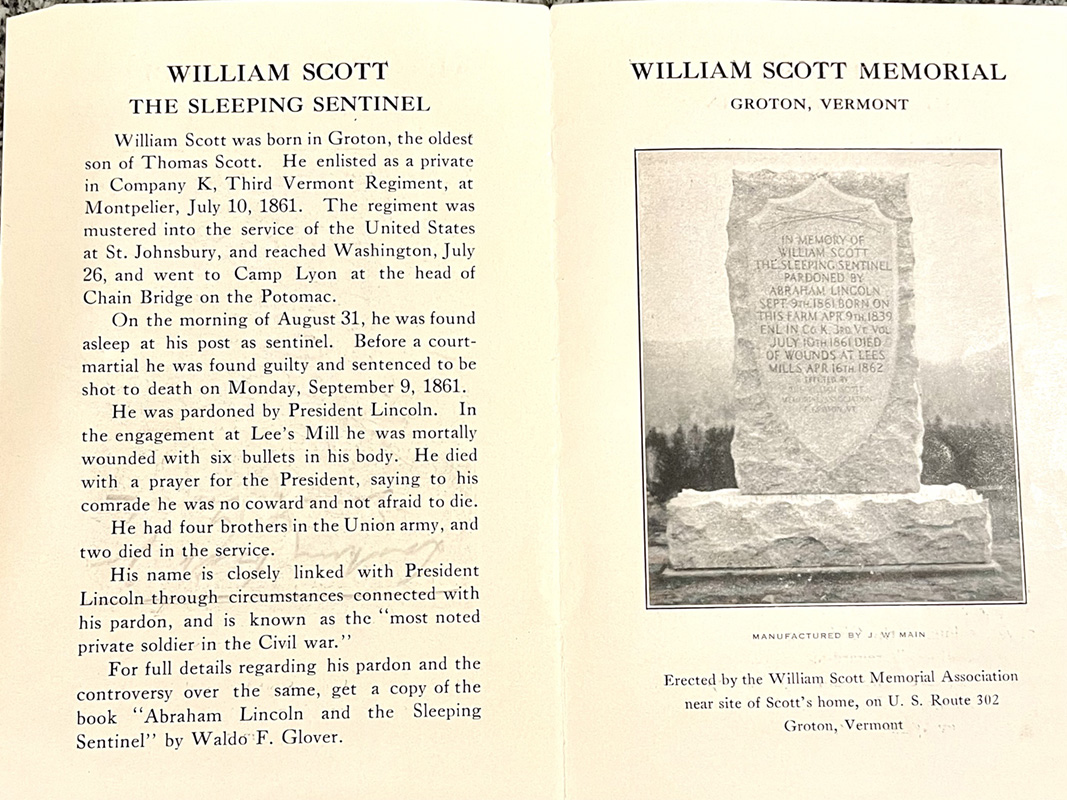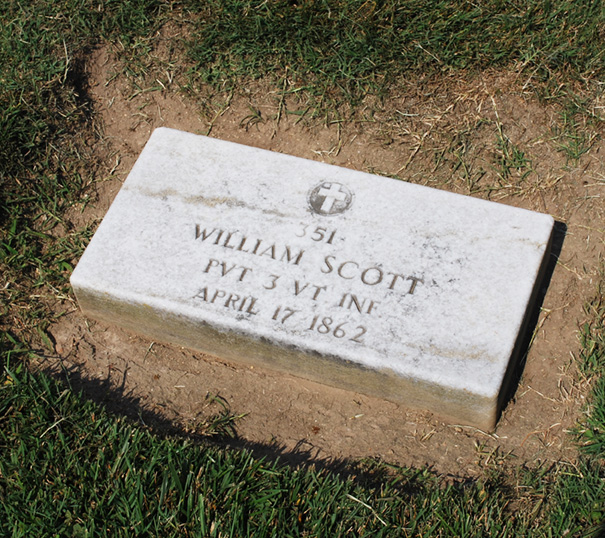THE STORY OF GROTON’S HISTORICAL SLEEPING SENTINEL
By Deborah Jurist – GHS President
This year – 2023 – we have been investigating historical events that happened in Groton or to people from Groton, and how they become stories, and even myths. We have been curious about how these stories become a part of who we are and… what we believe to be “true.”
Now we understand history is changing all the time. New discoveries are made, people retell events in ways that differ from the way they had been told in the past. We also now understand that we perceive the past based on our current beliefs.
Someone telling a “story” may have a reason to distort the facts, or they may not remember them accurately. It is important to look at original sources, learn who the “storyteller” is and read several accounts of the same event…. especially if your gut tells you something might be “off”
The more we study history and discover all the ways that the stories of our past have been manipulated, it helps sharpen our ability to recognize when stories about current events are being manipulated, what we now refer to as “misinformation.”
We can recognize even subtle manipulations in the reporting of current events, and we now have more tools than ever to help verify what our guts tell us might be “fishy”. By studying the way distortions happened in the past we learn….it is NOT “worse” than ever before, and we get better at recognizing “baloney” when we see it.
The following is basically a book report on Waldo Glover’s book, “Abraham Lincoln and the Sleeping Sentinel”, which is an in-depth and masterly study of using original sources.
Who was William Scott?
His father, Thomas, was born in Scotland, his mother Mary was from Groton.
He was born April 6, 1839, the oldest of 7 children, 6 boys, one girl.
Let’s talk about his mother. In summary and from records only, William Scott’s mother, Mary, had a baby every two years starting at the age of 28. One baby boy died at the age of two, and she had another boy that same year. Her last child, Filander, which means “loving mankind” in Greek was born two years later. She was 43 years old.
Five of her sons served in the Army during the Civil War. Four died during the war. John made it through and lived until 1921. He is buried in the West Groton Cemetery. Those who died were William: 23, George: 21, Joseph: 18, and Daniel: 16 years old. Mary died at the age of 54, just 6 months after her youngest soldier child died in Virginia.
The same year Mary died, Thomas remarried. He had 3 more children. The second one was named William T Scott.
How much did “regular people” know about the political climate and what led up to the Civil War?
We often think we know so much more now than folks did back then, but they were not ignorant of the battle over slavery and what it meant for the country that their grandparents had fought and died for. Three years after the Constitution was signed, according to the census, there were 300,000 slaves in America. In 1860, the year Lincoln was elected, the number was practically 4 million.
Mr. Glover wrote about how people in Groton were informed of current events. During the war, “Every evening except Sunday a large portion of the male population would gather at the store of Hosea Welch II to await the arrival of the daily stage from Wells River, bringing in the mail and the one copy of the daily newspaper. After the mail was sorted and distributed Mr. Welch, the storekeeper and postmaster, would take a vantage position, adjust the kerosene lamp, and read from the Boston Journal the news of the day to a most eager and attentive audience.”
Here is an anecdote showing that folks in Groton were tuned into the national news. Henry Clay Glover, (Waldo Glover’s father) was born in 1846, in Groton. His parents, Otis and Esther Glover must have had a strong admiration for Henry Clay, who was a Whig and was devoted to the power of the legislature as opposed to the president. Certainly this shows they were aware of national issues.
Finally, in 1860 Vermonters voted resoundingly for Abraham Lincoln, even though the northern democratic candidate (Stephen Douglas) was from Brandon, VT. Abraham Lincoln, won Vermont with 75% of the popular vote, the highest percentage in the country. Wikipedia
I was very curious about how our Groton boys became soldiers in the Union Army. There was not a draft, but quotas were created, whenever Lincoln, as Commander in Chief, called for troops. Waldo Glover writes about it in “Mr. Glover’s Groton”.
“At first when it was thought that the subjugation of the Confederacy would be an easy matter, it was not difficult to fill the town’s quota with volunteers, the men taking whatever pay the federal and state governments offered, but when the situation became increasingly serious, Groton, like all other towns began to offer bounties for enlistments.
He cites six Special Town meetings during the war when the people of Groton voted for “Bounties,” what we might call “signing bonuses”. They ranged from $50 to $600 depending on the length and type of duty the soldier would have. At the regular Town Meeting in March of 1865, Groton voted a tax of $4.00 on the Grand List to pay for these bounties. Groton sent a total of 79 men overall, 17 died.
Now that we have set the stage, let’s begin the story of Groton’s Sleeping Sentinel, William Scott. We are going to do this “Detective Columbo style” meaning we will tell how it ends, then we will discover how the story unfolded.
The Summary
William Scott volunteered on June 1st, 1861. On August 31, he fell asleep on guard duty. He was tried for this offense, convicted and sentenced to be shot to death. The execution was set, he was brought before the firing squad, but… he was pardoned at the last minute, on Abraham Lincoln’s orders. In April of the next year, Scott was mortally wounded in the battle of Lee’s Mills. He is buried in Yorktown National Cemetery in Pennsylvania.
This story was particularly appealing to the public. It became a symbol of Lincoln’s generous heart. Here was a good boy’s well intentioned act to help a fellow soldier, who had stood sentry the night before, but everything went horribly wrong.
It was told in newspapers, memoirs, biographies, school books and even as a hugely popular poem. It was exaggerated and embellished over and over as individuals placed themselves in prominent parts of the events.
In the 1920’s a well respected Lincoln scholar, named William Barton, published a new biography of the president, in it he denied that Lincoln actually pardoned William Scott at all.
Waldo Glover took this inaccuracy very seriously and he participated in an editorial battle that was carried on between the New York Times and the Boston Herald among other papers. At the conclusion of this controversy, Barton traveled to Vermont to apologize to Civil War veteran Luke Ferriter. He had actually been on guard duty with Scott, and was detailed to be part of the firing squad. – Barre Times article July 5, 2018 An Attack on the Sleeping Sentinel by Paul Heller
Glover’s book. “Abraham Lincoln and the Sleeping Sentinel was published by the Vermont Historical Society in 1936.
William Scott’s Story – The Beginning
The Civil War officially began, with the bombardment of Fort Sumter, on April 12, 1861. Regiments of soldiers were called to duty. William Scott and seven others from Groton went to St. Johnsbury, and enlisted in the third Regiment on June 1st.
They then traveled by train to Washington; it took two days. They marched to the head of the Chain Bridge which spanned the Potomac River from Washington to Virginia. Here at Camp Lyon the regiment was led by Brigadier General William Smith, a Vermonter, known as “Baldy.”
Seth Eastman, (author of the Civil War Journal, published by the GHS) also enlisted in the Third Regiment, at the same time as William, but according to his memoir, he got cold feet. He climbed the wall at the Fairgrounds in St Johnsbury and ran home by following the railroad tracks; it took him eight hours. He re-enlisted in the 6th regiment in Bradford a few months later.
Baldy Smith worked to make this motley collection of untrained soldiers into a disciplined brigade. “Drill, picket duty, fatigue duty, together with an occasional all night vigil in the rifle pits, constituted the daily routine.” A series of stern rules with punishments were instituted. One of these rules provided that the soldier found asleep on picket duty would be shot to death.
On August 31, William Scott was found asleep by a Sergeant and was arrested. He was brought before a general court martial on Sept 3rd, and the order was read to him. He was asked if he objected to any detail and he said “no”. The Court found him guilty. He was sentenced to be shot to death on Sept. 9th. The death warrant was issued by Major General McClellan. This original warrant is at the Fairbanks Museum.
What Happened Next
Sept 7: a petition, signed by 191 officers and privates asking that the life of William Scott be spared was submitted to “Baldy”.
Sept 8: General McClellan wrote a letter to his wife saying, “Mr. Lincoln came this morning to ask me to pardon a man that I had ordered to be shot…..”
Sept 9: the regiments of the brigade were drawn up in a hollow square in the morning, to witness the execution of William Scott; the firing squad took its position, the prisoner was brought forth, the death sentence was read to him…..then the pardon was read which said, “Viewed in connection with the inexperience of the condemned as a soldier, his previous good conduct and general good character, and the urgent entreaties made on his behalf, the Major General has determined, to grant the pardon so earnestly prayed for” signed by Major General McClellan.
The story of the pardon was published in newspapers in Vermont, Boston, Washington and Philadelphia. Some had a political slant, some embellished the story.
Sept 10: the National Republican of Washington had an editorial which stated “We are opposed to capital punishment but if there is an offense for which a man should be put to death, we think young Scott committed it” however, the article continues on to praise Lincoln for his pardon…. in this case.
Sept 14: An article was published in the Green Mountain Freeman by a lawyer from Montpelier named Francis Randall. He adds to the story that Lincoln traveled on horseback to Camp Lyon the night before to make sure that a potential faulty telegraph transmission which might have delayed the pardon did not overrule his wishes. This article was republished at least six times by other Vermont newspapers.
Sept 15: the Sunday Morning Chronicle of Vermont ran an article that stated “It is a tribute to the great goodness of heart of our excellent President”.
Sept 19: the Vermont Phoenix wrote that Gen. McClellan was prepared to execute Scott, but Lincoln “interposed to save his life”.
Waldo Glover cites two reactions in Groton:
Mrs. Elmira Welch said, “She remembered, as a girl, she had spent the day of the planned execution of Scott with his Mother, trying in every way possible to comfort her”.
He also writes: “So great was the gratitude in the Scott family that Thomas Scott, William’s father, on a visit to see his other sons, called on the President to thank him personally for pardoning William and, upon hearing that Thomas had no help on his farm in Groton, Lincoln gave him $10.
The Rev. Joseph Hamilton of the Methodist Episcopal Church in Vermont told the story of William Scott several years after the war. At the end, an old man came up to him and told him that he was Thomas Scott, and retold the tale of his trip to Washington.
After the Pardon
In March 1862, the Vermont Brigade made the journey with “rain overhead and mud under foot” to Virginia, to a base which became known as Camp Misery. Here they were ravaged by disease and cold and several died. General McClellan was building a large army for a great attack on Richmond. We have 4 letters that Scott wrote during this time.
There is an anecdote from this period, told by Arthur E. Worthen of St Johnsbury, “Scott couldn’t keep step to a march to save his life, and whoever marched in front of him was greatly annoyed by Scott hitting his heels”.
The Peninsula Campaign had begun. The Confederates were bivouacked on high bluffs above Yorktown. A stream below their encampment had been dammed up in two places to make mill ponds. One was called Lee’s Mill. The Federal Soldiers spent many days bringing down siege guns from Washington and building “corduroy roads” which were made of logs over swampy areas.
On April 16, McClellan ordered that the building of fortifications by the Confederates at Yorktown be stopped. General Smith posted his sharpshooters in the woods and brought out his artillery. This began the first infantry charge of the Civil War!
Four companies, including Scott’s Vermont 3rd Regiment burst out of the woods and waded across the waist high river, holding their cartridges in one hand and their muskets in the other, amidst a shower of bullets, they charged up the bank and routed the enemy…. who fled. While they waited for reinforcements, the Confederates rallied and made a counter attack. Waldo writes, “To their dismay, the Vermonters discovered that, notwithstanding their precautions crossing the river, much of their ammunition was ruined by water. Sharing with one another whatever dry cartridges were to be found, they held their ground and waited, hemmed in on three sides. Of the 192 men who made that heroic charge into the jaws of death, barely 100 returned unharmed. Among the mortally wounded was William Scott”.
William Scott died a hero at the Battle of Lee’s Mill
April 21, 1862 The Philadelphia Inquirer ran an article with the following headline: A THRILLING ROMANCE: TRUTH STRANGER THAN FICTION
A DYING SOLDIER PRAYS FOR PRESIDENT
The events leading up to the pardon were summarized in the article, then it continues “ ‘Suppose’, thought the President ‘that my pardon has not reached him’…bring up my carriage! And soon important state matters were dropped and through the broiling sun and dusty roads he rode to camp, about 10 miles and saw that the soldier was saved”.
The first man who fell at Lee’s Mills with 6 bullets in his body was William Scott of Company K. His comrades caught him up, and as his life blood ebbed away, he raised to heaven and amid the din of war, the cries of the dying and the shouts of the enemy, he made a prayer for the President, and remarked that he had shown that he was no coward and not afraid to die”.
The story of Scott’s burial in a grove of “holly and vines and a few cherry trees in full bloom was told. It goes on to say that as the grave was dug, a skeleton of a Revolutionary soldier was found along with some metal buttons in the exact spot where Scott was buried.
This story of Scott’s death was printed in northern newspapers, and a book by Frank Moore called “Anecdotes, Poetry, and Incidents of the War”, and thus it gained a permanent place in the literature of the Civil War.
The Men who Made the Story Famous
Waldo Glover now speaks directly to the way an event becomes a myth….
He begins, “It should require no effort of the imagination to perceive that a series of events such as is recorded in the preceding pages would, very readily, lend itself to exaggerated treatment”.
Francis De Hayes Janvier and James E. Murdoch
First came Francis De Hayes Janvier who wrote a poem, “The Sleeping Sentinel” 1863.
Then a famous elocutionist, named James Murdoch read the poem…. first at the Executive Mansion, to President Lincoln, his wife and guests.. Then he read it in the Senate Chamber with the President and wife present again. He read it in Philadelphia to a crowd of 3,000 and then in Boston, Baltimore, Albany and other cities.
Here is an excerpt:
While yet his voice grew tremulous, and death bedimmed his eye-
He called his comrades to attest he had not feared to die!
And, in his last expiring breath, a prayer to heaven was sent,
That God, with his unfailing grace, would bless our President.
Sergeant Isaac W. Ambler
A Sergeant named Ambler took huge liberties with Scott’s story in his autobiography. He placed himself praying with Scott, before the scheduled execution. He was the first to describe a man on horseback riding up, waving his sword above his head carrying the pardon by President Lincoln at the execution.
“When the word fell on Scott’s ear he ran to me (meaning Ambler) and fell on my neck with both arms around me, exclaiming ‘I am saved.’ “
George G. Benedict
“Vermont in the Civil War”, by Col. George Benedict, published in 1886, was authorized by the legislature of Vermont. In it, he tells of Lincoln’s personal carriage ride to the camp the night before the scheduled execution. He recounts Scott’s dying prayer for Lincoln, and describes his resting place as a grove of cherry trees where the remains of a Revolutionary soldier were unearthed, including his belt clasp and buttons.
Lucius E. Chittenden
The most famous version of the story was by Lucius Chittenden in his 1891 “Recollections of President Lincoln and his Administration.” During the Civil War, Chittenden, a lawyer from Burlington, became Registrar of the Treasury, at Lincoln’s request. Chittenden was a member of the very famous Vermont family who had given the state its first governor. This early Gov. Chittenden was also responsible for the first division of land in the town of Groton, and was honored with the first pick of the lots. He chose lot #21, subsequently sold it to Dominicus Gray, who sold it to Waldo Glover’s Grandparents Otis and Esther in 1840.
Chittenden devoted a chapter to Scott’s story. It was so popular that a pamphlet of just this chapter was published. His version became the basis for most subsequent stories. He claimed that the Vermonters seeking Scott’s pardon tried to hire him as a lawyer to secure a new trial. Instead,….he led them directly to President Lincoln, who agreed to halt the execution.
He also wrote that Lincoln visited Scott at the Camp the night before the scheduled execution and he promised to pardon him but for a fee. Scott offered to mortgage the family farm! Then Lincoln explained that, when he died, Scott would have to be able to look Lincoln in the eye and say ‘I have done my duty’
His retelling of Scott’s death is quite romantic to say the least….. He claimed that Scott, as he was dying, pleaded with Chittenden to bring a message to Lincoln. He also took credit for having Scott’s body buried in the grove of cherry trees which, according to Chittenden, also contained a stately oak in its center and that they carved “W.S” in the tree and the words “A Brave Soldier”
Finally, Chittenden says he carried Scott’s message to Lincoln, and was praised by the President for intervening on Scott’s behalf.
George G. Benedict revisited
Eight years after Benedict’s authorized history of the Civil War, he gave a talk on “Romance in Military History”. He corrected his own recounting of the story, which had largely been based on Chittenden’s account. He ends by saying, “But the fable has had a strong hold of the public heart, and it will undoubtedly long outlive the belated prosaic correction, if indeed the latter ever obtains general currency”.
The Controversy
William Barton had already published many books about Lincoln by 1925 when his “Life of Abraham Lincoln” came out. This time he included the story of William Scott. He had read the Chittenden version and declared, “Mr. Chittenden was not the greatest liar in Washington; he was not. But he was one of many men who colored their memories with their imagination until their accounts became wholly unsafe as historical data”. Barton declared “Who pardoned the prisoner or mitigated his sentence does not appear on record.”
It is worthwhile to point out that during this period the “Lost Cause” myth was being popularized. This was a narrative that the Confederacy was not fighting to preserve slavery, but rather that the war was simply about economics and that, for instance, Robert E. Lee was the best General in the war. This was the period when statues of Confederate Officers were erected and Federal Officers were discredited….including Lincoln.
The error in Barton’s biography was exposed. Barton decided to “try again.” This time he discovered the pardon that had been signed by General McClellan. However, Barton’s claim had taken hold.
The Boston Post published an article which ended “There is not the slightest evidence that President Lincoln ever heard of Scott’s case. There is nothing to show that he ever issued a pardon to Scott. The story told by Mr. Chittenden is flatly contradicted by the records”.
The next development…..a veteran named Luke Ferriter from Brattleboro spoke up. He had been recorded as one of the men on guard duty with William Scott. He also had the horrible luck of being randomly chosen to be one of the squad to “do the shooting.” as he put it.
He unequivocally states that
- They had heard that Lincoln had pardoned Scott the night before and
- Lincoln was there when Scott was pardoned! Ferriter’s response launched a full scale battle that took place in the New York Times, the Boston Herald, the Burlington Free Press, Brattleboro Reformer and the Barre Times. The opinions of the writers were as varied as were the stories that had been told over the last 65 years.
Eventually Barton conceded in the New York Times that he had made 4 errors in his “Life of Lincoln”:
He admitted that Lincoln knew about Scott’s case.
He admitted that Gen. McClellan’s letter to his wife, referred to Scott.
He admitted that the Regiments were drawn up and heard the pardon.
He admitted that Chittenden had some credibility.
Waldo Glover wraps up the controversy in the final section of his book.
Had Scott taken an extra night of sentry duty for his friend? Mr. Glover had correspondence with a man from Barre who knew the Sergeant in Company K. He said he always blamed himself for allowing Scott to stand in for his sick friend.
Who actually brought the case to Lincoln? It seems there might have been more than one person. General Smith “Baldy” thought that the execution should go forward, Scott’s supporters might have felt the need to have the petition delivered by another messenger. It might well have been Chittenden.
Did President Lincoln visit the encampment on the morning of the 9th? Even though Mr. Ferriter says, “There was no disputing that Lincoln was there. He stepped from the background. We stacked arms and cheered for him. He took off his hat in recognition of us, and we cheered again and again.” Waldo Glover seems to doubt that Lincoln was there the morning of the pardon. However, he does have more than one witness who corroborates that Lincoln was at Camp Lyon the night before and that he was cheered by the men.
Did Scott thank and pray for Lincoln on his deathbed? It seems quite possible that he could have done so before he fell unconscious; the surgeon who tended to him did not see him for several hours after he had fallen into a coma.
Was Scott buried in a Revolutionary Soldier’s grave? Contemporary newspapers did state that the Vermont dead at Lee’s Mills were buried on ground used by Revolutionary soldiers as a burial place during the siege of Yorktown.
And the cherry trees? George Philbrick, who was a friend of Scott’s said, “I did not see him after he was killed, but I saw where he was buried in a peach grove. The trees were all blossomed out, and it was a beautiful place”.
Finally…..was there a document showing Lincoln’s signed pardon?
I visited the Vermont Historical Society Library while doing research for this story and I learned that in the 1990s a group of autograph hunters came across the pardon with an authentic Lincoln signature! To get a copy one would have to get it from the Library of Congress. No easy task, as it was explained to me, but there is an article about it in the photo album.
The Monument and the Naming of Rt 302 as Scott Highway
For these two subjects I refer to John (Willard) Benzie:
For a community project, in the 1930’s the Groton Grange wanted to erect a monument to honor William Scott, the Sleeping Sentinel, whose story was being challenged by skeptics. Probably the idea was to write it in stone and hopefully preserve history. They formed the William Scott Memorial Association.
They collected donations from individuals and businesses. James Main manufactured the monument in his stone shed from Groton granite which is a relatively soft granite. Hence, the monument now has several blemishes on its face. McLure’s Student Band of Groton, played one of their first concerts at the dedication which was billed as a “Pilgrimage of Veterans of the Grand Army of the Republic” on June 25, 1936. The same year that Waldo Glover’s book was published.
Several attempts were made to have U. S. Highway 302 named for the Sleeping Sentinel before Groton’s Legislative Representative, Mrs. Nellie Jeffrey, introduced a resolution in 1945 to name the road that passes through our town the William Scott Memorial Highway. It passed unanimously.
